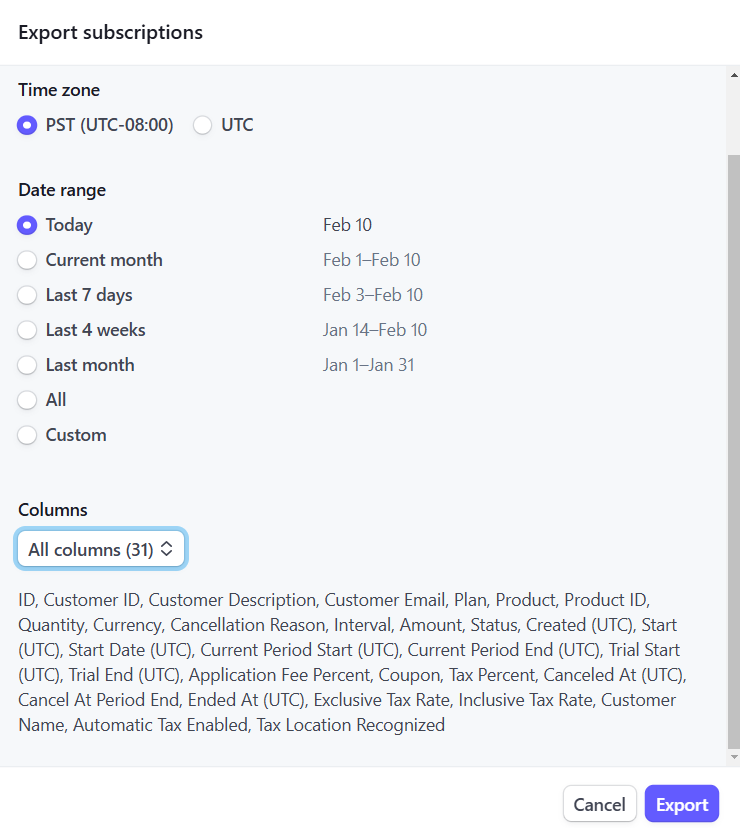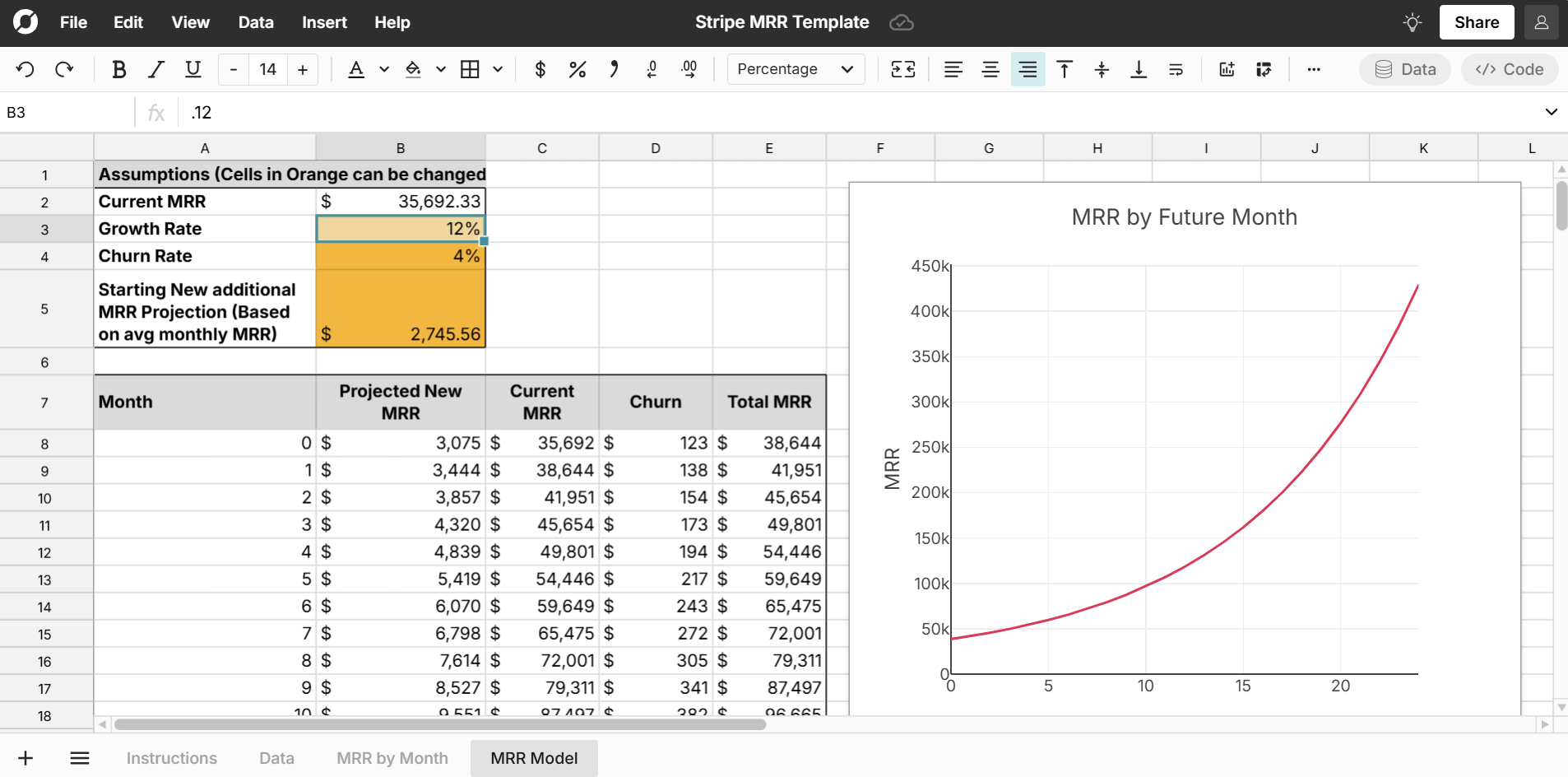Monthly Recurring Revenue is an important metric for software-as-a-service (SaaS) and subscription-based businesses to track and analyze. Not only does it provide a clear view of predictable income to help run your business, but it’s also typically the key input in determining the valuation of a SaaS or subscription-based company should you try to raise funding or sell your business.
We’ve created a Row Zero template for turning a standard Stripe subscriptions report that you can run with a couple of easy steps into a full MRR analysis, complete with a forward-looking model. If you want to just dive right into the template, click here or jump to the Stripe MRR Analysis Template section to read about how to use the template.
Table of Contents
- What is MRR?
- MRR vs ARR
- Why is MRR Important?
- Steps to Calculate MRR
- Stripe MRR Analysis Template in Row Zero
- Conclusion
What is MRR?
Monthly Recurring Revenue (MRR) is the predictable and recurring revenue a company expects to generate every month from its subscription-based customers. Unlike one-time sales or irregular income streams, MRR provides a clear, consistent view of revenue that you can rely on for planning and forecasting.
MRR vs ARR
Annual Recurring Revenue (ARR) is a similar metric to MRR; both are metrics used to track recurring revenue, typically from subscriptions. The difference is simply in the time duration over which you normalize revenue. As the name implies, ARR is an annual metric, while MRR is a monthly metric. ARR is usually used for longer term planning and a more overall picture of the financial position of the business. Due to the shorter duration, MRR is generally a better metric for tracking short-term changes in revenue and impacts of operational changes, like marketing campaigns, price adjustments, or new features.
Why is MRR Important?
1. Financial Stability and Predictability
MRR offers a stable and predictable revenue stream, which is essential for budgeting and financial planning. By knowing how much revenue you can expect each month, you can allocate resources efficiently, plan for operational expenses, and set aside funds for growth initiatives. This predictability also reduces financial uncertainty, a common challenge for startups and growing businesses.
2. Tracking Growth
MRR is one of the most reliable indicators of growth in a SaaS business. By monitoring changes in MRR over time, you can assess whether your business is expanding, stagnating, or contracting. Growth in MRR often signals an increase in customer acquisition, upselling success, or improved customer retention.
3. Investor Confidence
For SaaS companies seeking funding, MRR is a critical metric that investors scrutinize. A steady or growing MRR demonstrates that the business has a scalable and repeatable revenue model, which is a key factor in attracting investment. Investors value the predictability of MRR because it reduces the risk associated with their financial commitments.
4. Identifying Trends and Opportunities
Breaking down MRR into its components—such as new MRR, expansion MRR, contraction MRR, and churned MRR—helps identify trends and opportunities. For instance:
- New MRR: Revenue from new customers indicates how effective your acquisition strategies are.
- Expansion MRR: Additional revenue from existing customers (e.g., through upselling or cross-selling) highlights the success of account management and customer success teams.
- Churned MRR: Lost revenue due to cancellations can reveal issues with your product, pricing, or customer experience.
By analyzing these components, SaaS companies can pinpoint areas for improvement and double down on strategies that work.
5. Facilitating Forecasting
Accurate forecasting is vital for making informed business decisions, and MRR serves as the cornerstone of revenue projections. By analyzing historical MRR data and factoring in growth trends, businesses can predict future revenues, set realistic targets, and plan for expansion or cost-cutting as needed.
Steps to Calculate MRR
Here is the general process for calculating MRR. The Row Zero Stripe MRR Analysis Template does all of this for you, so feel free to skip ahead to the Row Zero Stripe MRR Analysis Template section to get started.
1. Identify Active Customers and Gather Revenue Subscription Details
First, identify all of your active customers and gather data on the start dates of their subscription, duration of their subscription, and their subscription amount. Since you are calculating monthly recurring revenue, you’ll want to normalize subscriptions to a monthly revenue amount. In other words, divide your annual subscription amounts by 12 and divide your quarterly subscriptions by 3.
2. Identify Customer Cancellations
Next, identify all of your customer cancellations and their cancel dates. This will help you understand your churn rate and what you should plan to subtract from your MRR projections each month to account for lost revenue from customers cancelling subscriptions.
3. Calculate your MRR
Next, calculate your MRR by summing all of your active revenue and subtracting out cancellations. You can do this on a month-by-month basis to give you an idea of your growth rate.
4. Project future MRR
Once you have your monthly MRR, you can project a growth rate and churn rates to predict MRR growth in future months.
Stripe MRR Analysis Template in Row Zero
We’ve created a Stripe MRR Analysis Template to easily turn a Stripe subscription report into an MRR analysis. You can view MRR trends over your subscription history as well as view future MRR growth projections based on your own churn and growth rate projections.
Assumptions
- Stripe offers a lot of different frequency subscriptions. This template only supports annual, monthly, and quarterly subscriptions. However, you can make some modifications to support other frequencies.
- We assume all subscriptions are Quantity = 1 and currency is USD (you can make modifications to support others).
- We ignore subscription trials - they aren’t considered in MRR or churn calculations.
Running the Subscriptions Report in Stripe
- In Stripe, navigate to the Subscriptions page
- Click on Export

- Click All Columns
- Click on the Export button to save as a .csv file

Loading Stripe Data Into the Template
- Open your .csv file that you exported from Stripe (steps above).
- Confirm that you have 31 columns of data.
- Delete the sample data in the blue columns on the Data tab.
- Paste in the report on the Data tab, matching the existing columns.
- Confirm that the 4 pink columns at the end of the data are present (Start Month, Start Year, Cancel Month, Cancel Year).
- The MRR by Month tab and the MRR Model tab should automatically populate.
Using the Template
The MRR by Month tab shows you a monthly breakdown of your MRR by interval, churn by interval, and MRR growth. The MRR Model tab shows future projected growth of your MRR. “Month 0” represents the current month. You can change the orange cells at the top of this tab to explore how different growth and churn rates would impact your MRR. 
Conclusion
MRR is a critical metric for SaaS and subscription-based businesses to track. It provides insight into the growth potential and financial stability of the business and is also a key part of a SaaS or subscription-based business’ valuation. With Row Zero, you can easily turn your Stripe data into actionable MRR analysis.